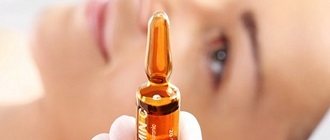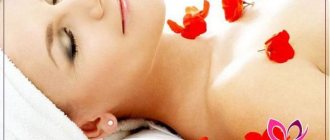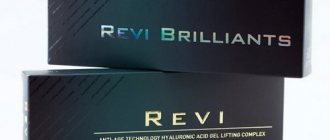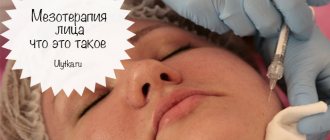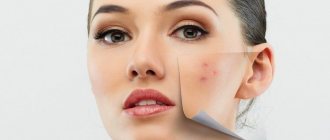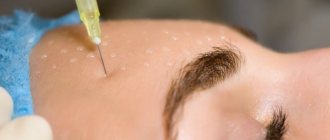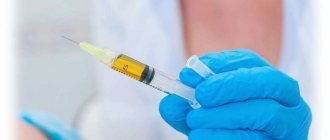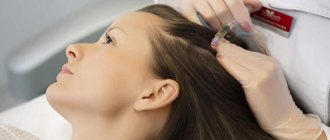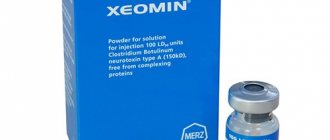The mesotherapy drug Triac is an effective means of combating cellulite deposits. Exposure to this synthetic substance, corresponding to thyroid hormone, activates the metabolic processes of proteins, lipids and carbohydrates. Triac mesotherapy can improve the functioning of the human cardiovascular and nervous systems.
The manufacturer of this solution is Spanish - one of the most successful enterprises producing biorevitalization and peeling rejuvenation products. The company uses advanced technologies in the production process. Her “arsenal” also includes a line of drugs designed for weight loss, one of which is Triac.
Indications and contraindications for use
Can!
A course of injections with this drug is indicated for people who are overweight. It breaks down local fat deposits and is effective in eliminating cellulite. This lipolytic also allows you to get rid of a double chin without leaving any unpleasant puffiness.
It is forbidden!
Triac is not recommended for patients who have been diagnosed with an allergy to iodine or have thyrotoxicosis - an excess of thyroid hormones in the body! People with heart problems associated with rhythm disturbances should also avoid injecting this drug.
Insertion of Triac is accompanied by severe pain, which can cause discomfort for clients with excessive sensitivity.
Mesotherapy - contraindications
No matter how useful mesotherapy is, it is not prescribed for everyone. The list of those who are denied such a procedure includes those people who have: hypertension, skin diseases, renal failure, vascular pathology, nephropathy,
third trimester of pregnancy, cholelithiasis, febrile diseases, hemophilia, taking anticoagulants or disaggregants.
Types of mesotherapy injections
- mesoinjections;
- mesopuncture;
- mesoperfusion;
- mesoinfiltration;
- nappage;
- papules technique or separate injections;
- Tracing technique for the correction of deep wrinkles.
When the injection is administered manually, this allows the drug to be administered even in the most inaccessible places and with thin dermis (skin). Also, there will be a minimum consumption of the drug. On the one hand, this is a saving on the drug, because its administration will be distributed evenly and in a smaller dose, but such manual work will be much more expensive than technical work. But if you take into account the fact that when injecting using an automatic injector, the procedure will not be as painful as with manual injection. This will especially apply to those patients who need mesotherapy injections for weight loss.
and for cellulite
.
After all, due to the fact that the problem area will be wider and larger than, for example, on the face. Of course, it is less painful and faster to carry out such a procedure with hardware, which is a plus.
Methods of drug administration and recommendations after the procedure
The maximum amount of the drug per injection procedure is 3 ml. How to inject the mesococktail depends on the localization of the patient’s fat deposits and the professional experience of the cosmetologist.
When taken at the correct dosage, Triac does not affect the functioning of parts of the brain and does not have a significant effect on blood pressure levels.
Within 24 hours after the procedure, the patient is not recommended to be exposed to sunlight or UV rays, as the drug can lead to photosensitivity.
Mesotherapy technologies. Injection technique for mesotherapy
In modern cosmetology, several types of effects on the dermis are used. Classic mesoinjections remain in demand - the injection of drugs to a depth calculated depending on the indications. This technology complies with all the canons developed by Pistor.
Recently, new effective techniques have emerged that allow deviations from classical execution:
- mesopuncture – superficial impact on acupuncture points;
- mesoinfiltration - the use of injections to penetrate the deep layers of the dermis;
- mesoperfusion – a single-use hardware administration of a medicinal cocktail in doses equal to several Lebel needles;
- non-invasive mesotherapy – achieving an effect without injections by treating problem areas with electrical impulses.
A professional cosmetologist knows several mesotherapy techniques that require a certain “hand positioning”. Among them are:
- nappage – performing a series of frequent microinjections, the volume of each of which does not exceed 0.02 mg;
- papular technique - the creation of papules (skin swellings) of various diameters to speed up the deposition of injected drugs;
- linear technique - injection into a canal formed in the dermis; Depending on its shape, there are such linear modifications as fan, tracer, tunnel and mesh (reinforcement).
There are manual and hardware mesotherapy. The first is more valuable, as it has the advantages of an individual approach, allows you to penetrate the most delicate areas and use medications sparingly.
It is advisable to use automatic injectors when treating large areas of skin. They make the procedure less painful, speed up its progress and make the doctor’s work easier. However, expensive equipment increases the cost of hardware manipulations.
Pros and cons of the drug
Recently, more and more controversy has flared up around Triac. Its undeniable advantages are the elimination of cellulite and activation of the process of melanogenesis. However, along with the positive aesthetic effect, injections of the drug can lead to health problems.
After conducting a series of studies, American scientists came to the conclusion that the use of the dietary supplement Triac is fraught with disruptions in the body. Experts have identified the following negative consequences from taking this drug:
- hormonal imbalance;
- disturbances in the circulatory process;
- problems with the thyroid gland;
- increased nervous excitability;
- changes in appearance.
One of the main arguments of opponents of the drug is the assertion that under its influence not only lipid deposits are destroyed, but also proteins.
Medicines used in mesotherapy
The success of a cosmetic procedure depends not only on the technical skills of the performer, but also on the competent selection of ingredients for a healing cocktail. Cosmetologists have at their disposal a whole range of medicines used in mesotherapy. They can be divided into two groups:
- traditional pharmacopeias: hophytol, procaine, trental, piroxi-cam, ribomunil, myacalcic, dicinone;
- specific for mesotherapy: lipodystrophin, Achyal, triac, embryoblast, X-ADN.
When selecting medications, the doctor proceeds from the indications for their use. At the same time, he is guided not only by the traditional grounds for carrying out the procedure, established during more than half a century of experience in mesotherapy, but also by new indications discovered in recent years.
The drugs used - both primary and auxiliary - should not cause addiction or rejection by the body. It should be borne in mind that in hypersensitive people a number of components can lead to undesirable consequences. The sulfurous acid salt, which acts as an antioxidant stabilizer, can cause an allergic reaction. Someone may develop an intolerance to parabens used as preservatives. Propylene glycol, which is part of injectable drugs, can also produce a toxic effect when administered intradermally.
In the world practice of aesthetic mesotherapy, there are two approaches to the selection of drugs for injection. Italian experts insist on the use of ready-made mono-medicines or multi-drug preparations prepared in special biotechnological laboratories. French doctors advocate a personal approach to patients, based on the compilation of arbitrary prescriptions for injection cocktails.
The second option requires more experience and knowledge from the doctor. After all, an erroneous combination of medications can cause drug incompatibility of a chemical or physical nature. Moreover, one drug can not only neutralize another, but also cause its action to have the opposite effect.
User reviews
Polina: “Lately I’ve started to worry about my extra pounds. A friend advised me to buy Triac because she injected it herself and she really liked the result. I decided to try it. Soon I began to notice that the fat was gradually disappearing. Now I look beautiful and fit. So both the figure and the mood are now just super!”
Ksenia: “For a long time I didn’t dare to inject myself with Triac. I've read so many horror stories about him. And then I decided: what the hell is not joking! And I took a course of injections. You know, everything bad that is written about Triac is nonsense. This is a great product that really helps you lose weight. And the price is quite reasonable.”
Inna: “I recently read a description of Triak on the Internet. I decided to try it. To be honest, at first I didn’t hope that I would run into him in Ulyanovsk. But I still managed to find it in one pharmacy. It was a little scary: they said the procedure was painful. But then I pulled myself together. As it turned out, the result was worth it. The skin became elastic, the big tummy was noticeably “blown away”. Thank you very much Triak!”
Cosmetical tools
Caffeine is a common component of anti-cellulite and anti-aging cosmetics: creams, serums, masks. At home, it is actively used for various wraps. Their fat-burning effect is manifested by creating a greenhouse effect, in which the active ingredients better penetrate the skin, stimulating blood flow and metabolic processes. Caffeine ampoules for cellulite can be used according to various recipes with the addition of other ingredients:
- Papaverine and honey.
- Ground coffee, white clay and milk.
- Capsicum ointment and baby cream.
Papaverine is another drug that is used in combination with caffeine. Its action is based on vasodilation and additional improvement of microcirculation in the “orange peel” area. Capsicam ointment has a similar effect, warming the skin at the site of application.
All ingredients specified in the recipe are thoroughly mixed. The leather is treated with them after preliminary cleaning. Having applied an even layer of the mixture to problem areas, they are first covered with cling film, and then wrapped in a blanket or warm clothing on top. The duration of the procedure is 40–60 minutes. Upon completion, the skin can also be treated with anti-cellulite cream.
For cellulite, caffeine solution is actively used for home wraps. Regular implementation of the procedure will soon yield results.
Caffeine is widely used in cosmetology, including due to its anti-cellulite properties. It activates blood flow in the affected area, eliminating hypoxia, accelerates metabolic processes and the breakdown of subcutaneous tissue lipids. By influencing the basic mechanisms of pathology, the substance helps make the skin smooth and elastic, restoring its natural beauty.
Overdose
When abused, caffeine (more than 300 mg per day, i.e. four cups of natural coffee, 150 ml each) can cause anxiety, restlessness, tremors, headache, confusion, and cardiac extrasystoles.
In newborns (including premature infants), at a blood plasma concentration of 50 mg/ml, toxic effects are possible: anxiety, tachypnea, tachycardia, tremor, increased Moro reflex, and at higher concentrations - convulsions. In this article you can read the instructions for use of the drug Caffeine
. Reviews of site visitors - consumers of this medicine, as well as the opinions of specialist doctors on the use of Caffeine in their practice are presented. We kindly ask you to actively add your reviews about the drug: whether the medicine helped or did not help get rid of the disease, what complications and side effects were observed, perhaps not stated by the manufacturer in the annotation. Caffeine analogues in the presence of existing structural analogues. Use for the treatment of low blood pressure (hypotension), spasms and drowsiness in adults, children, as well as during pregnancy and lactation.
Caffeine
- a psychostimulant and analeptic. It has a stimulating effect on the central nervous system, mainly on the cerebral cortex, respiratory and vasomotor centers. Increases mental and physical performance, reduces drowsiness and fatigue. Weakens the effect of CNS depressants. It has a pronounced effect on the cardiovascular system: it increases the strength and frequency of heart contractions, increases blood pressure during hypotension. Has a moderate diuretic effect. Increases the secretion of gastric glands.
Indications
- diseases accompanied by depression of the central nervous system, functions of the cardiovascular and respiratory systems (including poisoning with opioid analgesics, infectious diseases);
- spasms of cerebral vessels;
- decreased mental and physical performance;
- drowsiness.
Release forms
Solution for subcutaneous administration.
Tablets 100 mg Caffeine sodium benzoate.
Instructions for use and dosage
Injected subcutaneously or taken orally. Adults - 100-200 mg 2-3 times a day; children - 25-100 mg 2-3 times a day.
Side effect
- sleep disturbance;
- excitation;
- anxiety;
- with prolonged use, addiction is possible;
- tachycardia;
- increased blood pressure;
- arrhythmias;
- nausea, vomiting.
Contraindications
- arterial hypertension;
- organic diseases of the cardiovascular system (including severe atherosclerosis);
- glaucoma;
- increased excitability;
- sleep disorders;
- old age.
special instructions
It can be used as mono- or as part of combination therapy.
Drug interactions
When used simultaneously, the effect of sleeping pills and anesthetics is reduced.
With simultaneous use, it is possible to enhance the effect of analgesics-antipyretics, salicylamide, naproxen.
With the simultaneous use of estrogens (hormonal contraceptives, drugs for HRT), it is possible to increase the intensity and duration of action of caffeine due to inhibition of the CYP1A2 isoenzyme by estrogens.
When administered concomitantly with adenosine, caffeine reduces the increased heart rate and blood pressure changes caused by adenosine infusion; reduces vasodilation caused by the action of adenosine.
With simultaneous use, it is possible to increase the bioavailability, absorption rate and plasma concentration of acetylsalicylic acid.
With simultaneous use, mexiletine reduces the clearance of caffeine and increases its plasma concentrations, apparently due to mexiletine inhibition of caffeine metabolism in the liver.
Methoxsalen reduces the excretion of caffeine from the body with a possible increase in its effect and the development of toxic effects.
Due to the induction of microsomal liver enzymes under the influence of phenytoin, its simultaneous use accelerates the metabolism and excretion of caffeine.
Fluconazole and terbinafine cause a moderate increase in the concentration of caffeine in the blood plasma, while ketoconazole causes a less pronounced increase.
The most pronounced increase in AUC and decrease in clearance are observed with simultaneous use of caffeine with enoxacin, ciprofloxacin, pipemidic acid; less pronounced changes - with pefloxacin, norfloxacin, fleroxacin.
When used simultaneously, caffeine accelerates the absorption of ergotamine.
Analogues of the drug Caffeine
Structural analogues of the active substance:
- Dia-Activanad-N;
- Caffeine anhydrous;
- Caffeine sodium benzoate.
If there are no analogues of the drug for the active substance, you can follow the links below to the diseases for which the corresponding drug helps, and look at the available analogues for the therapeutic effect.
